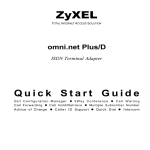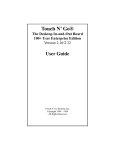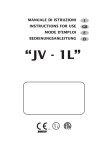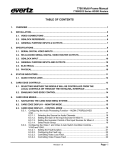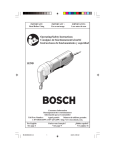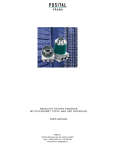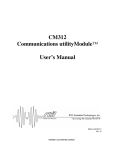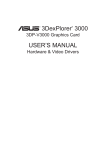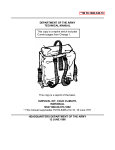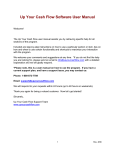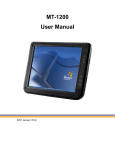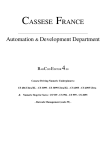Download Touch N` Go® - Touch N` Go Systems, Inc.
Transcript
Touch N’ Go® The Desktop In-and-Out Board 20 User Classic Edition Version 2.16/2.32 User Guide Touch N’ Go Systems, Inc. Copyright 1995 - 1998 All Rights Reserved 1 2 Table of Contents Introduction ............................................. ..4 Network Operation .................................. ..4 Installation ............................................... ..5 Server ........................................... ..6 Workstation ................................. ..9 Getting Started ......................................... 12 Editing and Adding Users........................ 13 Editing and Adding Remarks .................. 15 Display Screens ....................................... 18 Detailed Display Screen .............. 19 Mini Display Screen .................... 23 Clock........................................................ 24 Troubleshooting Hints ............................. 25 For More Information .............................. 27 part no. tng2.1632man 9-16-98 3 INTRODUCTION: Touch N’ Go is an easy-to-use software program primarily designed to track the in or out status of employees in a small to medium-sized office (up to 20 users). Unlike the standard in and out boards used in offices for years, Touch N’ Go operates electronically. Any user on your network can pull-up the Touch N’ Go board using either a detailed display screen or a mini display screen tailoring it to meet your office needs. (See the back cover illustrations for reference.) NETWORK OPERATION: Touch N’ Go uses a single data file residing on a networked fileserver or, in the case of Windows for WorkGroups, Windows NT, or Windows 95 & 98, in a shared directory. User windows (display screens) update the central data file as individual changes are made. Once every minute, the program queries the data file and updates all user displays with any changes made by users connected to the network. The Classic Edition has been tested and successfully runs under the following network operating systems: Novell, Windows for WorkGroups 3.11, Windows NT Server 3.5+, Windows NT Workstation 3.51+ and Windows 95 and 98. The Classic Edition allows for both 16 and/or 32 bit server and workstation installations to operate in a network environment with a mixed windows platforms. 4 INSTALLATION: You must have a local area network in order for this program to function. Users will need read, write, and execute privileges in the directory where the Touch N’ Go server program resides. The installer will need the appropriate rights to install the program into the directory. Touch N' Go needs about 15 megabytes of disk space during installation. The amount of diskspace that is actually used after installation is dependent on whether the program files in the windows\system directory pre-exist or need upgrading. The maximum amount of disk space the 32bit program needs is 7.18 megabytes and the 16bit program needs 6.03 megabytes. The Touch N’ Go Classic Edition “Server” program directory will occupy approximately 1.68 to 2.19 megabytes of hard drive space during the initial installation (2.19 megabytes if the network has both 16bit and 32bit workstations). The Workstation program group will use approximately 1 kilobyte of hard drive space. Total disk space usage is dependent on whether program files need to be installed or updated in the windows\system directory. The range for the 32bit program can be from a few kilobytes to 4.98 megabytes. The 16bit program can be from a few kilobytes to 3.83 megabytes. Proper installation requires the “server” program to be installed first. The “server” program contains the main data file and executables. The workstation creates the executable shortcut in a program group. 5 SERVER INSTALLATION Before beginning the installation, log in as a user that has full read and write privileges for the directory you will be installing into (including the right to install programs). You must install Touch N’ Go, the Desktop In-and-Out Board into a directory that each user can read-from, write-to, and executeprograms in. The Touch N' Go Server program must be installed first on your server or a shared directory before the Touch N’ Go workstation installations. You can copy the setup.exe from the Touch N’ Go CD-ROM into a shared directory to run the installation over the network or place the Touch N’ Go CD into a CD-ROM to run the installation. The Touch N’ Go CD does have an autorun feature. When installing the “Server” program, it is best to install the program at the Server machine (unless you have a Novell network). Be sure all other applications are shutdown prior to installation. ♦ Win95/98 and WinNT4+: Place the Touch N’ Go CD in the CD-ROM. The autorun will bring up the installation screen. Or choose Start menu, choose Run, input the drive letter and setup.exe==> d:\setup.exe ✳ Win3.11 and WinNT3.5+: Go to Program Manager, choose File, choose Run and input the appropriate drive letter and type in setup.exe==> f:\setup.exe 6 1) The installation begins with a Select Installation Type dialog box. Choose either the 32 or 16 bit Server options. Then select OK to proceed or cancel to terminate the installation. 2) The Welcome! screen confirms you are installing the Touch N’ Go Server program. Press OK to continue the installation or cancel to terminate the setup. 3) A Registration Information dialog box appears next. Fill out the respective fields of the Registration form. When complete, select the OK button. A confirmation screen of the Registration Information appears next. Select Yes if the information shown is correct. Otherwise, select No so the correct information can be provided. 4) The Select Destination Directory dialog box appears with the default directory being C:\tngsvr. You may select another drive; and select or create another directory appropriate for your organization. It is recom7 mended to create directory names that are eight characters or less. **Please note it is important that the Server directory be accessible by all users. The following graphics show two different server installations: one on a Novell network and one on a WinNT server. Novell Win NT Record the server name and sub-directory where you are installing the Touch N’ Go server files. You will need this information when you are installing the workstation files. When you click OK on the Select Destination Directory dialog box, an installation progress indicator appears. 5) Next you are prompted to Select Program Manager Group. You may use the default Touch N’ Go group name, choose an existing group from the list box, or type in a new name for the program group. Click OK to complete the server installation. The 8 program manager group will appear with the Touch N’ Go Server 32 or 16 shortcut. You are now ready to begin installing Touch N’ Go, the Desktop In-and-Out Board workstations. WORKSTATION INSTALLATION The Server installation must be performed prior to the Workstation installation. If a drive mapping to the machine with the server program does not exist, create one now so you won’t have to terminate the installation and create one. The Workstation setup program will install the necessary program files into the workstation’s windows \system directory and create a shortcut icon in a program manager group. This icon will launch the Touch N’ Go program executable located in the Server directory. Run the workstation installation on each workstation that will be running Touch N’ Go, the Desktop In-and-Out Board. You can copy the setup.exe from the Touch N’ Go CD into a shared directory to run the installation over the network or place the Touch N’ Go CD into the local machine’s CD-ROM. The Touch N’ Go CD does have an autorun feature. Be sure all other applications are closed prior to installing the Touch N’ Go program. ♦ Win95 & 98 and WinNT4+: Place the Touch N’ Go CD in the CD-ROM. The autorun will bring up the installation screen. Or choose Start menu, choose 9 Run, input the drive letter and setup.exe==> d:\setup. exe ✳ Win3.11 and WinNT3.5: Go to Program Manager, choose File, choose Run and input the appropriate drive letter and type in setup.exe==> f:\setup.exe 1) Upon starting the setup program, you will get a Select Installation Type dialog box. Choose either the 32 (Win95 & 98 or Win NT) or 16 bit (Win 3.x) Workstation option. Then select OK to begin installation or Cancel to terminate the setup. 2) The Welcome! screen confirms you are installing the Touch N’ Go Workstation program. Press OK to continue the installation or cancel to terminate the setup. 3) The next window is the Select Destination Directory dialog box prompting you for the drive and directory path for the Touch N’ Go server program. 10 Use the bottom drive box to pick the correct drive letter where server program is located. (The drive letter may be different from one workstation to the next.) If a drive mapping does not exist to the server program, terminate the installation and create the drive mapping. Use the middle box to choose the correct directory or sub-directory, or type in the full drive and path-name in the box. Click the OK button when the correct path to the server program is noted in the path statement, or Cancel to terminate the program. An installation progress indicator will keep you posted on the installation process. 4) The last step Select Program Manager Group will contain the shortcut icon for the Touch N’ Go Workstation. You may use the suggested program group name Touch N’ Go, choose an existing program group in the bottom box, or type in a new Program Group name in the top box. Click the OK button when done. Installation is complete when the Program Group with the TNG Workstation 32 or 16 shortcut icon is displayed. 11 Your Touch N’ Go installation for this workstation is now complete. Continue Workstation installations on all machines that will be running the Touch N’ Go, the Desktop In-and-Out Board. GETTING STARTED Once Touch N’ Go has been installed on your computer, you are ready to use it. Double click on the Touch N' Go shortcut to open the application. Your initial Touch N' Go window will look similar to the following illustration. Editing names and remarks is performed from the Detailed Display Screen by selecting the Admin menu option. Editing can be done from any workstation running Touch N’ Go, as well as, the main server program. Please refer to the following section, EDITING AND ADDING USERS. Changes will be immediately seen on the computer where the changes are made and will appear on all other networked computers within one minute (or immediately if F5 is pressed). 12 EDITING AND ADDING USERS In the Detailed Display Screen (which is the default window when the program initially starts), click on the Admin menu and choose Edit/Add User, or use the shortcut key strokes Ctrl + U. A window will appear called User Add/Edit. To edit a name (like the default names: User 1, 2 or 3), select the name from the drop down text box and then click on the Edit button at the bottom of the window. A window like the one below will appear containing the name to be edited (in this case, User 1 was selected). 13 Names will automatically be sorted in alphabetical order (or numerical order first should you number the names first). If you would like the names to be displayed alphabetically by last name, enter the last name first. When you are done, click on the OK button or press Enter. The name will be loaded into the User list. You can check to see that the user’s name has been entered correctly by clicking on the downward pointing arrow button at the end of the name box. This will allow you to view the entire list of users without returning to the Touch N’ Go display screen. To add a new user, click on the Add button in the User Add/Edit window. Enter the user’s name using the format you would like names to appear when viewing Touch N' Go’s display screen. Press Enter or click on the OK button when you are done. The example above would add ‘Jon Goodfellow’ as a user, showing his name on the Touch N’ Go screen display as it has been typed here. (See the illustration on the following page for reference.) When adding new users, they will be shown as OUT by default (with a red background). The Remarks section of the display will note ‘Unknown’ until their 14 status is changed or updated. For more information on remarks, see the following section EDITING AND ADDING REMARKS. To change the status to IN, left click on the OUT button following the user’s name. The background for that user will turn green, their status button will change to IN and their ‘Remarks’ text box will disappear. To delete names from the list of users, select a name from the user drop down menu box, click on the Delete button from the User Add/Edit window (remember, you can get to this window from the Touch N’ Go screen through the Admin menu, or by typing Ctrl+U). A confirmation screen will verify that you want to delete the user. This version of Touch N’ Go allows a maximum of 20 names. EDITING AND ADDING REMARKS Touch N’ Go Classic Edition includes four default remarks (Doctor, Lunch, Meeting, Out). These remarks may be edited, deleted, or more standard remarks can be added to the remarks list. 15 Remarks are used to provide extra information about the status of users who are OUT of the office or IN* the office but unavailable. When changing to IN* (in but unavailable) or OUT of the office, a remarks window appears. You can choose to type in a specific message, use one of the messages from the standard remarks list or no message (in which case the program inputs the text, ‘Unknown’ and the time of departure). To view the standard remarks select on Edit/Add Remarks in the Admin menu (shortcut keystrokes is Ctrl + R) and then click on the downward pointing arrow circled below. You can add, edit, or delete the standard remarks. To add new standard remarks, click on the Add button in the Remarks Add/Edit window. This will give you a blank box where you can type your new standard remark (“Client Location” in the example shown below). When your entry is complete, click on the OK button or 16 press Enter and the remark will be added to the list of standard remarks. To edit or delete pre-existing standard remarks, select the remark you would like to change from the drop-down list of standard remarks. Then click on the Edit or the Delete button. If you have chosen to Delete your selection, a confirmation screen will popup. Click on the OK button and the deletion is finalized. You can also choose to Cancel the deletion at this time. If you chose to Edit your selection, the program provides you with the edit box where you can make your changes of the selected remark. When you are done, press Enter or click on the OK button and the edited selection will replace the original selection in the list of standard remarks. When you are finished editing or adding to the list of standard remarks, select the Close button. When you close the Remarks Add/Edit window, you will be taken back to the Touch N’ Go Detailed Display Screen. From this window, you can use the remarks function by left clicking on the IN button of any user to change their status to OUT, or right clicking to IN* (unavailable). A window entitled Remarks will appear (see illustration below). type here or select 17 You have the option to either type in your own specific message, or you can click on the downward pointing arrow to select a choice from the standard list of remarks. Click on the OK button after you have made your remark’s selection or typed in a specific message. If no selection is made, the Touch N’ Go board will note the remarks as ‘Unknown’. The time of each departure is automatically placed in the Remarks box preceding the text information. DISPLAY SCREENS For your convenience, Touch N’ Go offers two different types of display screens. The Detailed Display Screen displays all users, their current status noted on the status button, a remarks field, and all the features in the menu bar are available. The Mini Display Screen displays only the user’s name with their status background color. The actual remarks of each user can be viewed for one user at a time by placing the mouse cursor over the user’s name to display the status at the bottom of the Mini Display screen. Either type of screen can be viewed at any time on any workstation using Touch N’ Go. Both display screens work in a similar fashion: - Red indicates person is OUT of the office, - Green indicates person is IN office, and - Yellow indicates person is IN* or unavailable. 18 (See the color illustrations on the back cover for reference.) A user may change their status using either display screen. Using the Detailed Display Screen, the user will left or right click on the status button following the user’s name. The Mini Screen Display, the user double left clicks (OUT) or right clicks (IN*) on the user’s name. When changing a user’s status from IN to IN* or to OUT a remarks window will appear, allowing the input of comments. For more information on remarks, see the section EDITING AND ADDING REMARKS. THE DETAILED DISPLAY SCREEN The Detailed Display Screen is where you can perform all Touch N’ Go functions, including the editing of the users and standard remarks. When viewing the Detailed Display Screen, a status button is shown directly following each user's name that corresponds to the background status color of the user’s name. When a user is IN or OUT of the office, the button will be titled IN (with a green background) or OUT (red background), and IN* (yellow background) indicates that the user is in the office, but not available. 19 These buttons are also used to change the user’s status from IN to OUT or IN*. By left or right clicking on the status buttons, the users alters their status. See the table below for details. Detailed Display Screen if status is... left click results in: right click results in: IN (green) OUT (red) IN* (yellow) IN* (yellow) IN (green) OUT (red) OUT (red) IN (green) IN* (yellow) 20 When the status button notes OUT or IN*, the time of departure and the remarks are displayed under the remarks column. When changing a user from OUT or IN* to IN, any comments in their Remarks field are erased. Remarks are used to indicate the user’s whereabouts, contact information, or when the user is expected to be back. The Remarks window allows you to select from any number of pre-existing standard remarks (i.e. lunch, meeting, doctor, sick, etc.), or you may type in unique comments into the input box that is provided. For more details refer to the section EDITING AND ADDING REMARKS. When you click the OK button or press the Enter key while in the Remarks window, the window automatically closes. The user’s status button changes from IN to OUT (or IN*), and the background of the user’s name goes from green to red (or yellow). The Detailed Display Screen also contains a menu bar. There are five options on the menu bar: File, Admin, Mini Display, About and Help. File menu has two options: Update (shortcut key option is F5): will immediately query the Server data file and update the workstation’s Touch N’ Go screen with the latest changes. (The workstation screen is automatically updating every minute.) Exit (shortcut is Ctrl + X): closes Touch N’ Go. 21 Admin menu has two editing options: Edit/Add Remarks (shortcut is Ctrl + R): allows you to add, modify, or delete any of the standard remarks. For more information on this, see the section EDITING AND ADDING REMARKS. Edit/Add User’s (shortcut is Ctrl + U): allows you to add, modify, or delete any of the users. For more information on this, see the section EDITING AND ADDING USERS. Mini Display menu option: Mini Display switches you from the Detailed Display Screen to the Mini Display Screen. The Mini Display Screen recaps the users in their status background color without the remarks column. This allows for a smaller display screen, however, individual status remarks can be retrieved by placing the mouse cursor over a user’s name. See more information in the following section, THE MINI DISPLAY SCREEN. About menu option: The About window offers Touch N’ Go’s company and support contact information, program version number, and where the Touch N’ Go server program directory resides. Program version will note a 2.16 for the 16 bit version of the program or a 2.32 indicating the 32 bit version. Help menu option: Help opens up Touch N’ Go’s electronic help file. 22 THE MINI DISPLAY SCREEN By selecting MINI DISPLAY from the main menu, the Detailed Display Screen window is closed and a condensed version of the In-and-Out board is displayed. This feature reduces the size of the display on your monitor, yet still displays the status of all users. The Mini Display shows the color status of all users in a similar format to the Detailed Display Screen, however, it does not display a remarks field for all users. Instead, comments can be retrieved for any user by placing the mouse cursor over the user’s name. This will display the user’s name, time and remarks in the status bar (refer to the following illustration) at the bottom of the Mini Display Screen. Users may change their status while using the Mini Display Screen by clicking or double-clicking on their names using the appropriate mouse buttons. (See the following chart for reference.) 23 Mini Display Screen if user is... place mouse cursor over name: double click results in: right click results in: IN (green) user’s status OUT (red) IN* (yellow) IN* (yellow) user’s status IN (Green) OUT (red) OUT (red) user’s status IN (green) IN* (yellow) To close the Mini Display Screen and bring up the Detailed Display Screen, click on the DETAIL menu option. THE CLOCK When a user’s status changes from IN to OUT or IN*, the time of departure is automatically placed in the Remarks window before the comments. This time runs off of the computer’s system time. If the time needs to be adjusted, refer to your system’s operating manual for instructions. 24 TROUBLESHOOTING HINTS 1) Permission Problems If you are having trouble installing the Server Program or getting the Workstations to work, the most likely cause is having improper network permissions. To install the Server Diskette, you must have full read and write privileges for the directory you will be installing to, including the right to create files, and it must be installed to a directory that each user can read-from, write-to, and execute-programs-in. If you have problems, it is best to install the Server program at the server computer. All of the Workstations must have full concurrent read, write, and execute-rights within the directory that you install into from the Server program. Don’t forget that if you altered a user’s privileges to allow read, write and execute privileges, that user may need to log in again before the newly added privileges take affect. 2) Long directory names: It is best to keep directory names to eight characters or less even if you are installing the 32bit version of the program. The workstation shortcut will browse for the server program and will usually accept the long filename during the browsing process. 3) Touch N’ Go includes a database repair and compact utility. Compacting the database periodically will keep the program’s performance optimized. The 16bit program’s repair/compact utility is called 25 16rep.exe and the 32bit program’s utility is called datarep.exe. They both are run in a similar fashion: from the Start menu, select Run and browse to the TNGSVR directory and run the datatrep.exe (32bit version) or 16rep. exe (16bit version). When prompted, select Repair/ Compact Database – all users will need to be out of the Touch N’ Go program for this utility to run. 4) Support Website: Our Support Website is updated with known issues as they arise. Support can be found at: http://www.touchngo.com/tng/Support/index.htm 26 FOR MORE INFORMATION You can contact Touch N’ Go Systems, Inc. product support via telephone, fax, e-mail, or the World Wide Web. • • • • • Ordering or general Product information, call 1 800 691-6333 Product Support Technician, call 1 907 264-6333 Fax number is: 1 907 274-9493 E-mail address is [email protected] or [email protected] Latest services and products on the web is http://www.touchngo.com/tng/ Touch N’ Go’s support Website address is: http://touchngo.com/tng/Support/index.htm Touch N’ Go Systems, Inc. 406 G Street, Suite 210 Anchorage, Alaska 99501-2164 27 28




























